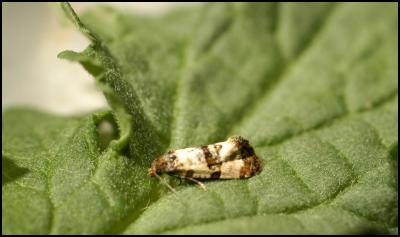Mighty moths flown in to ravage ragwort
Mighty moths flown in to ravage ragwort

PHOTO CAPTION: Anything but
boring: This crown boring moth has arrived in New Zealand
with an important mission - to destroy the noxious pasture
pest, ragwort. PHOTO: Hugh Gourlay
New
troops have arrived to wage war on one of New Zealand's
worst weeds, and are undergoing safety checks before being
deemed battle-worthy.Ragwort (Senecio jacobaea) replaces
pasture, and can cause fatal liver damage if eaten by cattle
and horses.
Biological control agents including the ragwort flea beetle have been released nationwide to attack ragwort plants. But although these have destroyed significant amounts of ragwort (up to 100% in some cases), they have failed to make a real indent on the West Coast, where overall, the problem is as bad now as it was 20 years ago. Landcare Research has been leading the charge to find alternative biocontrol agents, better suited to the wet conditions of areas like the West Coast.
Landcare Research weed researcher Hugh Gourlay says that with ERMA (Environmental Risk Management Authority) approval, about 350 ragwort crown boring moths (Cochylis atricapitana) have just arrived in New Zealand. The moths were placed in containment upon arrival, and over the next 18 months will undergo testing to determine whether they will eat anything other than ragwort.The crown boring moths will be joined next month by the ragwort plume moth (Platyptilia isodactylus).
The plume moths will also be kept in containment and undergo the same tests. Mr Gourlay says the moths are of European origin, but have been sourced from Tasmania, where they both have successfully established in the wild. "The two moths are better adapted to wet soils and wet climates than the ragwort flea beetle.
Some areas of Tasmania have a wet climate similar to the West Coast, and a similar ragwort problem.
"The crown boring moths have had good results there. Ragwort plants attacked by them produce fewer seeds, and show reduced growth and flowering. In some cases, the moth kills the entire plant.
"The plume moth attacks the roots of ragwort plants. It is too early to tell the plume moth's overall impact in Tasmania, but early results look promising.
"Neither moth has eaten any plant besides ragwort, which is also an encouraging sign."
Mr Gourlay says the new arrivals are the first new agents for the biocontrol of ragwort since 1981 when the ragwort flea beetle was introduced.Subject to approval from ERMA, the moths will be released into the West Coast environment by the end of 2005.
Several other places of similar climate throughout New Zealand may benefit from the introduction of these moths, including Southland and Waikato.
The project to import the moths was initiated by West Coast farmers and the New Zealand Landcare Trust, with funding from farmers, the Ministry of Agriculture and Forestry Sustainable Farming Fund, the West Coast Development Trust, the West Coast Regional Council, the Department of Conservation, Forest & Bird (West Coast branch) and Westland Milk Products.
ENDS


 Business Canterbury: Urges Council To Cut Costs, Not Ambition For City
Business Canterbury: Urges Council To Cut Costs, Not Ambition For City Wellington Airport: On Track For Net Zero Emissions By 2028
Wellington Airport: On Track For Net Zero Emissions By 2028 Landcare Research: ANZAC Gall Fly Release Promises Natural Solution To Weed Threat
Landcare Research: ANZAC Gall Fly Release Promises Natural Solution To Weed Threat NZ Anti-Vivisection Society: Auckland Rat Lovers Unite!
NZ Anti-Vivisection Society: Auckland Rat Lovers Unite! University of Canterbury: $1.35 Million Grant To Study Lion-like Jumping Spiders
University of Canterbury: $1.35 Million Grant To Study Lion-like Jumping Spiders Federated Farmers: Government Ends War On Farming
Federated Farmers: Government Ends War On Farming



